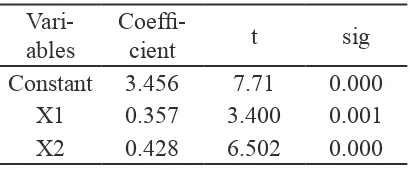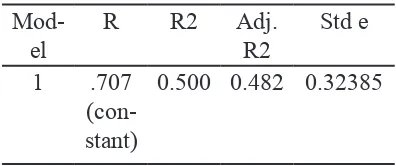The Effect of Leadership Style on Motivation
to Improve the Employee Performance
Hanifah STMT Trisakti
Novi Indah Susanthi STMT Trisakti
Agus Setiawan STMT Trisakti
ABSTRACT
Human resources (HR) is one of the most important factor in an organization, especial-ly for PT. PELNI, a prominent goverment-owned marine transportation company.This study aims to determine the factors which can improve the performance of employees at PT.PELNI. Upon getting feed back from 78 employees, it is obvious that the company has apparently been successful in motivating its employees to demonstrate good performance. Success indication can be seen from the regression coefficient X2 (Work Motivation) of 0.428. While the regression coefficient X1 (Leadership Style) of 0.357. This indicates that the motivation influences employee performance greater than leadership. Accordingly, PT. Pelni can be taken as an example of a good company in motivating its employees.
Introduction
In an organization, leaders and em-ployees must work together different tasks in order to achieve expected results. Ev-ery leader, must have their own leadership style. Mulyadi and Rival (2009) mention-that leaders in theirleadership era needs to think as well as to demonstrate leadership styles. By having a certain leadership style, then, an employer will be able to affect the performance of employees in an organiza-tion. In other words, leadership style plays an important role in running the organiza-tion.
Furthermore, in addition to leader-ship style, an important element of value in an organization is work motivation. Hando-ko (2003) stated that work motivation is an individual’s personal circumstances that encourage the willingness of the individu-als to perform certain activities in order to achieve a goal. Similarly according to Umar (1999); motivation is a factor that can lead to job satisfaction and improve employee performance. In organization life, employ-ees need to get a boost as a form of work motivation to improve their performance. Thus, work motivation has to get serious attention from the leader of an organization or the management, especially for leaders whose daily work is directly in contact with subordinates in the workplace. Thus, moti-vation is an important variable that needs to receive serious concern from the organiza-tions in improving employee performance. As mentioned previously, employee is one of the main elements that has a cru-cial role in determining the progress of the organization. Employee performance is important to note because it can affect the achievement of organizational goals and the level of survival in the ever increas-ingly intense global competition. In other words, employees are important human re-sources to achieve the organizational goals and employee performance in an organiza-tion needs to get a really measurable
as-sessment. In other words, the performance assessment is determined by the results of the human resources (HR) activities with performance standards previously set out by the organization.
There are some variables that can affect the performance of the employees, which according to Wirawan (2009) and Suranta (2002), are leadership style and work motivation. Employee performance is highly integrated with the role of the leader while the motivation is needed by the employee to work. Not only do lead-ership style and work motivation concern private organizations but also become a great concern of the state owned transpor-tation company known such as PT PELNI (PT Indonesian National Shipping) which serves to provide marine transportation ser-vices which includes transport of passen-gers and cargo freight among the islands in the country.
The method used in this study is a survey method, while technical analysis of the data use a combination of descriptive statistical techniques.
Meanwhile, the data used are primary data concerning the social profile and iden -tification of respondents, and secondary data is a source of research data obtained indirectly by researchers.
Results and Discussion
50 years. Furthermore, in the longest length of service, only 3 employees who have worked for> 30 years and 1 employees who have worked between 5 to 10 years. This indicates, that PT. PELNI is able to moti-vate and maintain the employees presence to keep working.
Table 1 Profile of Respondents
No. Description N Percentage
1 Gender Male 36 49.3
Female 35 47.9
Senior High 18 25.0
D3 4 5.6
<5 years 17 23.3
5-10 years 1 1.4
11-20 years 30 41.1 21-30 years 22 30.1 >30 years 3 4.1
Total 73 100.0
Furthermore, based on the educa-tion level, the majority of employees of PT. PELNI are university graduates in un-dergraduate levelwith as many as 42 em-ployees, only 11.1% are in graduate level. Then, a high school graduate employees amounted to 17 people and D3 4 people. This shows, education of employees at PT. PELNI very varied.
The hypothesis presented in this study are as follows:
Hypothesis 1
H0: ρy1 = 0 there is no relationship between leadership style with the performance of the employee;
H
o: ρy1>0 there is a positive relationship
between leadership style to employee
performance.
Hypothesis 2
H0: ρy2 = 0 there is no relationship between work motivation and performance of employees;
Ho: ρy2>0 there is a positive relationship between work motivation and performance of employees.
Hypothesis 3 H
0: ρy3 = 0 there is no relationship
between leadership style and work motivation and performance of employees; Ho: ρy3 >0 there is a relationship between leadership style and work motivation and performance of employees.
The multiple linear regression calcu-lation between Leadership Style (X1), and work motivation (X2) on Employee
Perfor-mance (Y) shows the following results:
Table 2 Cofficient
Vari-ables
Coeffi
-cient t sig
Constant 3.456 7.71 0.000
X1 0.357 3.400 0.001
X2 0.428 6.502 0.000
Source: primary data
The results of the multiple linear regression equation above indicates that constant value of 3.456 means that if it is not influenced by the variables; Leader -ship Style (X1) and work motivation (X2),
then, Employee Performance (Y) will not change (constant). In addition, b
1
(regres-sion coefficient X1) of 0.357 means that if the Leadership Style (X1) is further im-proved while the other variables are fixed (constant), then, Employee Performance (Y) will increase. Lastly, b
coefficient) of 0.428 has a meaning that if the work motivation (X2) on employ-ees increased, whereas the other variables are fixed (constant), then, Employee Per -formance (Y) will increase. Based on the regression equation, the most dominant factor in influencing work motivation em -ployee performance is proven by the value of the greatest regression coefficient; that is equal to 0.428 which results in regression equation Y = 3.456 + + 0,428X2 0,357X1.
The magnitude of the variable per-centage of Employee Performance ex-plained by the independent variable (co-efficient of determination) is indicated by the value of Adjusted R2 which equals to
0.500 using as independent variables in this study which is more than one. This means that the employee performance able to be explained by the leadership style and work motivation with a value of 50%, while 50% are explained by other variables not exam-ined in this study.
A t-test is completed to test the vari -ables’ relationship with results as seen in Table 3.
Table 3 Model Summary
Mod-Partial test results (t test) are listed in the table can be explained that the effect of leadership Styles on employee performance is shown with t value of 3.400 and the table = 2.000 with a significance value of 0.001 <0.05. So it can be said there is significant relationship between leadership style on employee performance is partially accept-ed. Furthermore, the effect of work moti-vation on employee performance is shown
with t value of 6.502 which is greater than the table = 2.000 with a significance value of 0.000 <0.05. So it can be said, there is a significant influence between work motiva -tion on employee performance.
Next, simultaneous test is used to test the hypotheses about the effect of leader-ship style and work motivation against em-ployee performance at the same time.
Table 4 ANOVA Regression 5.978 2 2.989 28.498 0.000 Residual 5.978 57 0.105
Total 11.956 59
-Source: primary data
Based on the results of the calcula-tions the calculated F values obtained for 28,498 with the results of significance of 0.000, while the degree of freedom in item 57 in table 2 and table F obtained a value of 3.16 so that the calculated F value of 28.498> F value table = 3.16 (signifi -cant). This may imply that the influence of the leadership style and work motiva-tion together havesignificant influence on employee performance. So the third hy-pothesis stating no influence of leadership style and work motivation simultaneously is rejected.
Conclusions and Recommendations
Based on the leadership style and mo-tivational work practiced by PT Pelni, then, it seems obvious that there is a significant relationship between leadership style on employees has improved the performance and motivation of all employees within the company, therefore, the attempts that have been made and the situation makes is worth maintaining.
related to performance, it would be best, to execute work motivation research be based on work environment and facilities provid-ed and which type of leadership style that is most effective to be implemented which enable the improvement of employee per-formance.
While for the next research area to be covered, it issuggested to examine other variables related to employee performance measurement which can not be studied by the present research which is work motiva-tion based on the work environment and facilities provided that includes the more effective type of leadership style which en-able the improvementof employees perfor-mance.
References
Alimuddin. 2002. Pengaruh Gaya Kepe -mimpinan terhadap Kinerja Pega -wai Badan Pengawasan Daerah Kota Makasar [Tesis] Program Pascasarjana Magister Manajemen Universitas Gajah Mada (Unpb -lished)
Bass, B.M dan Avolio. 1990. The Implica -tion of Transac-tional and Transfor-mational. Team and Organization
Development (4): 231-273.
Burton, James P. Lee, Thomas W. Holtom, Brooks C. 2002. The Influence of Motivation to Attend, Ability to At -tend, and Organizational Commit-ment on Different Types of Absence Behaviors. Journal of Managerial
Issue. Summer: 181-197.
Ferdinand, Augusty. 2006. Structural Equation Modeling Dalam
Peneli-tian Manajemen. Semarang: Badan
Penerbit Universitas Diponegoro. Hadi, Sutrisno. 1993.Metodologi Research
Jilid I. Yogyakarta: Andi Offset.
Luthans, Fred. 2006. Perilaku Organisasi
Edisi Sepuluh. Yogyakarta: Pener-bit Andi.
Mangkunegara, Anwar Prabu. 2000. Mana-jemen Sumber Daya Manusia
Peru-sahaan. Bandung: PT Remaja
Ros-dakarya.
Marzuki, Sukarno. 2002. Analisis Pengaruh Perilaku Kepemimpinan terhadap Kepuasan Kerja dan Kinerja Ac -count Officer : Studi Empirik pada Kantor Cab. BRI di Wilayah Jawa Timur. [Tesis] Program Pasacasar-jana Magister Manajemen Univer-sitas Diponegoro (Unpublished). Mas’ud, Fuad. 2004. Survai Diagnosis
Or-ganisasional Konsep dan Aplikasi.
Semarang: Badan Penerbit, BP-UNDIP.
Menon, Maria E. 2002. Perceptions of Pre-Service and In-Service Teach-ers Regarding the Effectiveness of Elementary School Leadership in Cyprus. The International Journal
of Educational Management. 16:
91-97.
Robbins, Stephen P. 2006. Perilaku Organ-isasi. Edisi kesepuluh. Jakarta: PT Indeks.
Siagian, S.P. 1999. Tehnik Menumbuhkan dan Memelihara Perilaku Organ-isasional. Jakarta: Haji Mas Agung.
Stoner, James A.F. Freeman, R. Edward. Gilbert, J.R, Daniel. R. 1996.
Mana-jemen Jilid I. Jakarta: PT Bhuana
Ilmu Populer.
Su’ud, Muh. 2000. Persepsi Sosial Tentang Kredibilitas Pemimpin. Sinergi
Ka-jian Bisnis dan Manajemen. 3(1):
51-65.
Sugiyono. 1999. Metode Penelitian Bisnis. Bandung: Alfabeta.
Ber-mutu. Usahawan. 1: 18-26.
Thoha, M. 2001. Kepemimpinan dalam
Manajemen, Suatu Pendekatan
Perilaku. Jakarta: Rajawali Press. Trisnaningsih, Sri. 2004. Motivasi
Seb-agai Moderating Variable Dalam Hubungan antara Komitmen den -gan Kepuasan Kerja. Jurnal Maksi.
4: 16 - 24.

